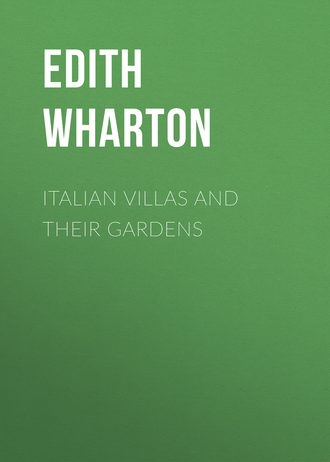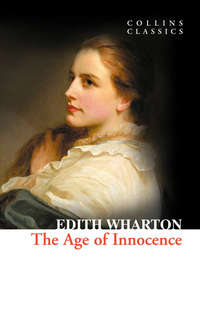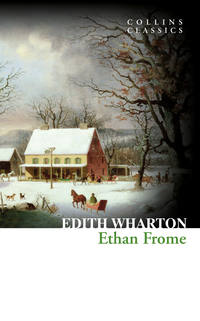 полная версия
полная версияItalian Villas and Their Gardens

Edith Wharton
Italian Villas and Their Gardens
INTRODUCTION
ITALIAN GARDEN-MAGIC
Though it is an exaggeration to say that there are no flowers in Italian gardens, yet to enjoy and appreciate the Italian garden-craft one must always bear in mind that it is independent of floriculture.
The Italian garden does not exist for its flowers; its flowers exist for it: they are a late and infrequent adjunct to its beauties, a parenthetical grace counting only as one more touch in the general effect of enchantment. This is no doubt partly explained by the difficulty of cultivating any but spring flowers in so hot and dry a climate, and the result has been a wonderful development of the more permanent effects to be obtained from the three other factors in garden-composition—marble, water and perennial verdure—and the achievement, by their skilful blending, of a charm independent of the seasons.
It is hard to explain to the modern garden-lover, whose whole conception of the charm of gardens is formed of successive pictures of flower-loveliness, how this effect of enchantment can be produced by anything so dull and monotonous as a mere combination of clipped green and stonework.
The traveller returning from Italy, with his eyes and imagination full of the ineffable Italian garden-magic, knows vaguely that the enchantment exists; that he has been under its spell, and that it is more potent, more enduring, more intoxicating to every sense than the most elaborate and glowing effects of modern horticulture; but he may not have found the key to the mystery. Is it because the sky is bluer, because the vegetation is more luxuriant? Our midsummer skies are almost as deep, our foliage is as rich, and perhaps more varied; there are, indeed, not a few resemblances between the North American summer climate and that of Italy in spring and autumn.
Some of those who have fallen under the spell are inclined to ascribe the Italian garden-magic to the effect of time; but, wonder-working as this undoubtedly is, it leaves many beauties unaccounted for. To seek the answer one must go deeper: the garden must be studied in relation to the house, and both in relation to the landscape. The garden of the Middle Ages, the garden one sees in old missal illuminations and in early woodcuts, was a mere patch of ground within the castle precincts, where “simples” were grown around a central wellhead and fruit was espaliered against the walls. But in the rapid flowering of Italian civilization the castle walls were soon thrown down, and the garden expanded, taking in the fish-pond, the bowling-green, the rose-arbour and the clipped walk. The Italian country house, especially in the centre and the south of Italy, was almost always built on a hillside, and one day the architect looked forth from the terrace of his villa, and saw that, in his survey of the garden, the enclosing landscape was naturally included: the two formed a part of the same composition.
The recognition of this fact was the first step in the development of the great garden-art of the Renaissance: the next was the architect’s discovery of the means by which nature and art might be fused in his picture. He had now three problems to deal with: his garden must be adapted to the architectural lines of the house it adjoined; it must be adapted to the requirements of the inmates of the house, in the sense of providing shady walks, sunny bowling-greens, parterres and orchards, all conveniently accessible; and lastly it must be adapted to the landscape around it. At no time and in no country has this triple problem been so successfully dealt with as in the treatment of the Italian country house from the beginning of the sixteenth to the end of the eighteenth century; and in the blending of different elements, the subtle transition from the fixed and formal lines of art to the shifting and irregular lines of nature, and lastly in the essential convenience and livableness of the garden, lies the fundamental secret of the old garden-magic.
However much other factors may contribute to the total impression of charm, yet by eliminating them one after another, by thinking away the flowers, the sunlight, the rich tinting of time, one finds that, underlying all these, there is the deeper harmony of design which is independent of any adventitious effects. This does not imply that a plan of an Italian garden is as beautiful as the garden itself. The more permanent materials of which the latter is made—the stonework, the evergreen foliage, the effects of rushing or motionless water, above all the lines of the natural scenery—all form a part of the artist’s design. But these things are as beautiful at one season as at another; and even these are but the accessories of the fundamental plan. The inherent beauty of the garden lies in the grouping of its parts—in the converging lines of its long ilex-walks, the alternation of sunny open spaces with cool woodland shade, the proportion between terrace and bowling-green, or between the height of a wall and the width of a path. None of these details was negligible to the landscape-architect of the Renaissance: he considered the distribution of shade and sunlight, of straight lines of masonry and rippled lines of foliage, as carefully as he weighed the relation of his whole composition to the scene about it.
Then, again, any one who studies the old Italian gardens will be struck with the way in which the architect broadened and simplified his plan if it faced a grandiose landscape. Intricacy of detail, complicated groupings of terraces, fountains, labyrinths and porticoes, are found in sites where there is no great sweep of landscape attuning the eye to larger impressions. The farther north one goes, the less grand the landscape becomes and the more elaborate the garden. The great pleasure-grounds overlooking the Roman Campagna are laid out on severe and majestic lines: the parts are few; the total effect is one of breadth and simplicity.
It is because, in the modern revival of gardening, so little attention has been paid to these first principles of the art that the garden-lover should not content himself with a vague enjoyment of old Italian gardens, but should try to extract from them principles which may be applied at home. He should observe, for instance, that the old Italian garden was meant to be lived in—a use to which, at least in America, the modern garden is seldom put. He should note that, to this end, the grounds were as carefully and conveniently planned as the house, with broad paths (in which two or more could go abreast) leading from one division to another; with shade easily accessible from the house, as well as a sunny sheltered walk for winter; and with effective transitions from the dusk of wooded alleys to open flowery spaces or to the level sward of the bowling-green. He should remember that the terraces and formal gardens adjoined the house, that the ilex or laurel walks beyond were clipped into shape to effect a transition between the straight lines of masonry and the untrimmed growth of the woodland to which they led, and that each step away from architecture was a nearer approach to nature.
The cult of the Italian garden has spread from England to America, and there is a general feeling that, by placing a marble bench here and a sun-dial there, Italian “effects” may be achieved. The results produced, even where much money and thought have been expended, are not altogether satisfactory; and some critics have thence inferred that the Italian garden is, so to speak, untranslatable, that it cannot be adequately rendered in another landscape and another age.
Certain effects, those which depend on architectural grandeur as well as those due to colouring and age, are no doubt unattainable; but there is, none the less, much to be learned from the old Italian gardens, and the first lesson is that, if they are to be a real inspiration, they must be copied, not in the letter but in the spirit. That is, a marble sarcophagus and a dozen twisted columns will not make an Italian garden; but a piece of ground laid out and planted on the principles of the old garden-craft will be, not indeed an Italian garden in the literal sense, but, what is far better, a garden as well adapted to its surroundings as were the models which inspired it.
This is the secret to be learned from the villas of Italy; and no one who has looked at them with this object in view will be content to relapse into vague admiration of their loveliness. As Browning, in passing Cape St. Vincent and Trafalgar Bay, cried out:
“Here and here did England help me: how can I help England?”—say,so the garden-lover, who longs to transfer something of the old garden-magic to his own patch of ground at home, will ask himself, in wandering under the umbrella-pines of the Villa Borghese, or through the box-parterres of the Villa Lante: What can I bring away from here? And the more he studies and compares, the more inevitably will the answer be: “Not this or that amputated statue, or broken bas-relief, or fragmentary effect of any sort, but a sense of the informing spirit—an understanding of the gardener’s purpose, and of the uses to which he meant his garden to be put.”
I
FLORENTINE VILLAS
For centuries Florence has been celebrated for her villa-clad hills. According to an old chronicler, the country houses were more splendid than those in the town, and stood so close-set among their olive-orchards and vineyards that the traveller “thought himself in Florence three leagues before reaching the city.”
Many of these houses still survive, strongly planted on their broad terraces, from the fifteenth-century farmhouse-villa, with its projecting eaves and square tower, to the many-windowed maison de plaisance in which the luxurious nobles of the seventeenth century spent the gambling and chocolate-drinking weeks of the vintage season. It is characteristic of Florentine thrift and conservatism that the greater number of these later and more pretentious villas are merely additions to the plain old buildings, while, even in the rare cases where the whole structure is new, the baroque exuberance which became fashionable in the seventeenth century is tempered by a restraint and severity peculiarly Tuscan.
So numerous and well preserved are the buildings of this order about Florence that the student who should attempt to give an account of them would have before him a long and laborious undertaking; but where the villa is to be considered in relation to its garden, the task is reduced to narrow limits. There is perhaps no region of Italy so rich in old villas and so lacking in old gardens as the neighbourhood of Florence. Various causes have brought about this result. The environs of Florence have always been frequented by the wealthy classes, not only Italian but foreign. The Tuscan nobility have usually been rich enough to alter their gardens in accordance with the varying horticultural fashions imported from England and France; and the English who have colonized in such numbers the slopes above the Arno have contributed not a little to the destruction of the old gardens by introducing into their horticultural plans two features entirely alien to the Tuscan climate and soil, namely, lawns and deciduous shade-trees.
Many indeed are the parterres and terraces which have disappeared before the Britannic craving for a lawn, many the olive-orchards and vineyards which must have given way to the thinly dotted “specimen trees” so dear to the English landscape-gardener, who is still, with rare exceptions, the slave of his famous eighteenth-century predecessors, Repton and “Capability Brown,” as the English architect is still the descendant of Pugin and the Gothic revival. This Anglicization of the Tuscan garden did not, of course, come only from direct English influence. The jardin anglais was fashionable in France when Marie Antoinette laid out the Petit Trianon, and Herr Tuckermann, in his book on Italian gardens, propounds a theory, for which he gives no very clear reasons, to the effect that the naturalistic school of gardening actually originated in Italy, in the Borghese gardens in Rome, which he supposes to have been laid out more or less in their present form by Giovanni Fontana, as early as the first quarter of the seventeenth century.
It is certain, at any rate, that the Florentines adopted the new fashion early in the nineteenth century, as is shown—to give but one instance—in the vast Torrigiani gardens, near the Porta Romana, laid out by the Marchese Torrigiani about 1830 in the most approved “landscape” style, with an almost complete neglect of the characteristic Tuscan vegetation and a corresponding disregard of Italian climate and habits. The large English colony has, however, undoubtedly done much to encourage, even in the present day, the alteration of the old gardens and the introduction of alien vegetation in those which have been partly preserved. It is, for instance, typical of the old Tuscan villa that the farm, or podere, should come up to the edge of the terrace on which the house stands; but in most cases where old villas have been bought by foreigners, the vineyards and olive-orchards near the house have been turned into lawns dotted with plantations of exotic trees. Under these circumstances it is not surprising that but few unaltered gardens are to be found near Florence. To learn what the old Tuscan garden was, one must search the environs of the smaller towns, and there are more interesting examples about Siena than in the whole circuit of the Florentine hills.
The old Italian architects distinguished two classes of country houses: the villa suburbana, or maison de plaisance (literally the pleasure-house), standing within or just without the city walls, surrounded by pleasure-grounds and built for a few weeks’ residence; and the country house, which is an expansion of the old farm, and stands generally farther out of town, among its fields and vineyards—the seat of the country gentleman living on his estates. The Italian pleasure-garden did not reach its full development till the middle of the sixteenth century, and doubtless many of the old Florentine villas, the semi-castle and the quasi-farm of the fourteenth century, stood as they do now, on a bare terrace among the vines, with a small walled enclosure for the cultivation of herbs and vegetables. But of the period in which the garden began to be a studied architectural extension of the house, few examples are to be found near Florence.
The most important, if not the most pleasing, of Tuscan pleasure-gardens lies, however, within the city walls. This is the Boboli garden, laid out on the steep hillside behind the Pitti Palace. The plan of the Boboli garden is not only magnificent in itself, but interesting as one of the rare examples, in Tuscany, of a Renaissance garden still undisturbed in its main outlines. Eleonora de’ Medici, who purchased the Pitti Palace in 1549, soon afterward acquired the neighbouring ground, and the garden was laid out by Il Tribolo, continued by Buontalenti, and completed by Bartolommeo Ammanati, to whom is also due the garden façade of the palace. The scheme of the garden is worthy of careful study, though in many respects the effect it now produces is far less impressive than its designers intended. Probably no grounds of equal grandeur and extent have less of that peculiar magic which one associates with the old Italian garden—a fact doubtless due less to defects of composition than to later changes in the details of planting and decoration. Still, the main outline remains and is full of instruction to the garden-lover.
The palace is built against the steep hillside, which is dug out to receive it, a high retaining-wall being built far enough back from the central body of the house to allow the latter to stand free. The ground floor of the palace is so far below ground that its windows look across a paved court at the face of the retaining-wall, which Ammanati decorated with an architectural composition representing a grotto, from which water was meant to gush as though issuing from the hillside. This grotto he surmounted with a magnificent fountain, standing on a level with the first-floor windows of the palace and with the surrounding gardens. The arrangement shows ingenuity in overcoming a technical difficulty, and the effect, from the garden, is very successful, though the well-like court makes an unfortunate gap between the house and its grounds.
Behind the fountain, and in a line with it, a horseshoe-shaped amphitheatre has been cut out of the hillside, surrounded by tiers of stone seats adorned with statues in niches and backed by clipped laurel hedges, behind which rise the ilex-clad slopes of the upper gardens. This amphitheatre is one of the triumphs of Italian garden-architecture. In general design and detail it belongs to the pure Renaissance, without trace of the heavy and fantastic barocchismo which, half a century later, began to disfigure such compositions in the villas near Rome. Indeed, comparison with the grotesque garden-architecture of the Villa d’Este at Tivoli, which is but little later in date, shows how long the Tuscan sense of proportion and refinement of taste resisted the ever-growing desire to astonish instead of charming the spectator.
On each side of the amphitheatre, clipped ilex-walks climb the hill, coming out some distance above on a plateau containing the toy lake with its little island, the Isola Bella, which was once the pride of the Boboli garden. This portion of the grounds has been so stripped of its architectural adornments and of its surrounding vegetation that it is now merely forlorn; and the same may be said of the little upper garden, reached by an imposing flight of steps and commanding a wide view over Florence. One must revert to the architect’s plan to see how admirably adapted it was to the difficulties of the site he had to deal with, and how skilfully he harmonized the dense shade of his ilex-groves with the great open spaces and pompous architectural effects necessary in a garden which was to form a worthy setting for the pageants of a Renaissance court. It is interesting to note in this connection that the flower-garden, or giardino segreto, which in Renaissance gardens almost invariably adjoins the house, has here been relegated to the hilltop, doubtless because the only level space near the palace was required for state ceremonials and theatrical entertainments rather than for private enjoyment.
It is partly because the Boboli is a court-garden, and not designed for private use, that it is less interesting and instructive than many others of less importance. Yet the other Medicean villas near Florence, though designed on much simpler lines, have the same lack of personal charm. It is perhaps owing to the fact that Florence was so long under the dominion of one all-powerful family that there is so little variety in her pleasure-houses. Pratolino, Poggio a Caiano, Cafaggiuolo, Careggi, Castello and Petraia, one and all, whatever their origin, soon passed into the possessorship of the Medici, and thence into that of the Austrian grand dukes who succeeded them; and of the three whose gardens have been partly preserved, Castello, Petraia and Poggio Imperiale, it may be said that they have the same impersonal official look as the Boboli.
Castello and Petraia, situated a mile apart beyond the village of Quarto, were both built by Buontalenti, that brilliant pupil of Ammanati’s who had a share in the planning of the gardens behind the Pitti. Castello stands on level ground, and its severely plain façade, with windows on consoles and rusticated doorway, faces what is now a highway, though, according to the print of Zocchi, the eighteenth-century engraver, a semicircular space enclosed in a low wall once extended between the house and the road, as at the neighbouring Villa Corsini and at Poggio Imperiale. It was an admirable rule of the old Italian architects, where the garden-space was small and where the site permitted, to build their villas facing the road, so that the full extent of the grounds was secured to the private use of the inmates, instead of being laid open by a public approach to the house. This rule is still followed by French villa-architects, and it is exceptional in France to see a villa entered from its grounds when it may be approached directly from the highroad.
Behind Castello the ground rises in terraces, enclosed in lateral walls, to a high retaining-wall at the back, surmounted by a wood of ilexes which contains a pool with an island. Montaigne, who describes but few gardens in his Italian diary, mentions that the terraces of Castello are en pante (sic); that is, they incline gradually toward the house, with the slope of the ground. This bold and unusual adaptation of formal gardening to the natural exigencies of the site is also seen in the terraced gardens of the beautiful Villa Imperiali (now Scassi) at Sampierdarena, near Genoa. The plan of the garden at Castello is admirable, but in detail it has been modernized at the cost of all its charm. Wide steps lead up to the first terrace, where Il Tribolo’s stately fountain of bronze and marble stands surrounded by marble benches and statues on fine rusticated pedestals. Unhappily, fountain and statues have lately been scrubbed to preternatural whiteness, and the same spirit of improvement has turned the old parterres into sunburnt turf, and dotted it with copper beeches and pampas-grass. Montaigne alludes to the berceaux, or pleached walks, and to the close-set cypresses which made a delicious coolness in this garden; and as one looks across its sun-scorched expanse one perceives that its lack of charm is explained by lack of shade.
As is usual in Italian gardens built against a hillside, the retaining-wall at the back serves for the great decorative motive at Castello. It is reached by wide marble steps, and flanked at the sides by symmetrical lemon-houses. On the central axis of the garden, the wall has a wide opening between columns, and on each side an arched recess, equidistant between the lemon-houses and the central opening. Within the latter is one of those huge grottoes1 which for two centuries or more were the delight of Italian garden-architects. The roof is decorated with masks and arabesques in coloured shell-work, and in the niches of the tufa of which the background is formed are strange groups of life-sized animals, a camel, a monkey, a stag with real antlers, a wild boar with real tusks, and various small animals and birds, some made of coloured marbles which correspond with their natural tints; while beneath these groups are basins of pink-and-white marble, carved with sea-creatures and resting on dolphins. Humour is the quality which soonest loses its savour, and it is often difficult to understand the grotesque side of the old garden-architecture; but the curious delight in the representations of animals, real or fantastic, probably arose from the general interest in those strange wild beasts of which the travellers of the Renaissance brought home such fabulous descriptions. As to the general use of the grotto in Italian gardens, it is a natural development of the need for shade and coolness, and when the long-disused waterworks were playing, and cool streams gushed over quivering beds of fern into the marble tanks, these retreats must have formed a delicious contrast to the outer glare of the garden.
At Petraia the gardens are less elaborate in plan than at Castello, and are, in fact, noted chiefly for a fountain brought from that villa. This fountain, the most beautiful of Il Tribolo’s works, is surmounted by the famous Venus-like figure of a woman wringing out her hair, now generally attributed to Giovanni da Bologna. Like the other Florentine villas of this quarter, where water is more abundant, Petraia has a great oblong vasca, or tank, beneath its upper terrace; while the house itself, a simple structure of the old-fashioned Tuscan type, built about an inner quadrangle, is remarkable for its very beautiful tower, which, as Herr Gurlitt2 suggests, was doubtless inspired by the tower of the Palazzo Vecchio.
According to Zocchi’s charming etching, the ducal villa of Poggio Imperiale, on a hillside to the south of Florence, still preserved, in the eighteenth century, its simple and characteristic Tuscan façade. This was concealed by the Grand Duke Peter Leopold behind a heavy pillared front, to which the rusticated porticoes were added later; and externally nothing remains as it was save the ilex and cypress avenue, now a public highway, which ascends to the villa from the Porta Romana, and the semicircular entrance-court with its guardian statues on mighty pedestals.











